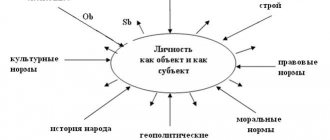PERSONALITY, one of the centers. concepts of philosophy and psychology, a person considered primarily. as an autonomous bearer and subject of culture, historically established forms of world relations, which he implements in his activities. Along with this, in psychology there is also a widespread understanding of personality as an individuality, a stable specific structure that develops during life. psychological characteristics of the individual that underlie his characteristic forms of behavior.
Historical development of the concept of personality
In classic Latin word "L." (persona) meant primarily a “mask” (cf. Russian “mask”) - a cast from the face of an ancestor, a ritual mask and a theatrical one, playing the role of a resonator, serving to amplify the sound of the voice; the associated tradition of elevating this word to the verb personare - “to sound loudly” is linguistically untenable. point of view, because the vowel “o” in these words has a different meaning. longitude In the Middle Ages, this word was interpreted as “to sound through oneself” (per se sonare) - a person, that is, is the one who has his own. voice (Bonaventura, 2 Sent. 3, p. 1, a. 2, q. 2). Dr. popular middle-century The etymology falsely attributed to Isidore of Seville is per se una (one in itself). Modern researchers trace this word to the Etruscan fersu (mask), apparently dating back to the Greek. πρόσωπον (face, front, mask).
Persona is a fundam. concept of Rome. jurisprudence (along with “thing” and “action”), designating a person as an individual occupying a specific position in society, while homo (man) designates him as an instance of a species, a caput (head) as a unit subject to taxes or carrying military duty. In this sense, the word persona is used by Cicero, who distinguishes four “personas” assigned by nature to a person: he has “mind and consciousness,” i.e., signs of the human race, belongs to a certain type of character, lives in a specific environment in certain circumstances and chooses a certain profession or way of life; Moreover, everyone “must be true to his nature” (treatise “On Duties”, book I, 109–120). Marcus Aurelius encouraged everyone to create their own. person
In the context of trinitarian debates in Christian theology, the word persona was first used by Tertullian (Adv. Praxean), in his formula of the trinity tres personae – una substantia (“three persons – one substance”). In intense theological discussions, the important milestones of which were the Councils of Nicaea (325) and Chalcedon (451), a final concept was developed. formula: “unity (of God) in three persons and one person (Christ) in two natures (human and divine)” (in the Greek tradition, the word hypostasis was used in this context, much less often - πρόσωπον). Boethius in Christology in the treatise “Against Eutyches and Nestorius” he gave a definition of L., which for a long time became classic: “individual substance of a rational nature” (naturae rationalis individua substantia). Richard of Saint-Victor, considering Boethius’s definition not entirely adequate, since substance answers the question “what?”, and personality answers the question “who?”, gave the following definition: “the incommunicable existence of rational nature” (intellectualis naturae incommunicabilis existentia). Alexander Gaelsky, based on the division of existence into the physical, rational and moral, made a distinction, respectively, between the subject, the individual and the personality: each L. is an individual and a subject, but only the possession of a special dignity makes the subject a person. Thomas Aquinas, who proclaimed L. “that which is most perfect in all nature,” considered it essential for L. to be the master of his actions, “to act, and not to be put into action” (S. Th. I, 29, 3 and 1) .
In the philosophy and culture of the Renaissance, L. began to be identified primarily with a bright, multifaceted individuality, capable of achieving anything he wanted.
At the center of J. Locke's concept of life is the phenomenon of self-consciousness, which accompanies every act of thinking and ensures the identity of the Self thanks to the ability of L. to remember his previous states. For I. Kant, who gave a justification for the concept of philosophy in the field of practical philosophy, philosophy is based on a person’s ability to act in accordance with the universal moral law, which gives her freedom in relation to the mechanism of nature; it is not a means, but “an end in itself,” and the requirement to treat a person in accordance with this is the highest ethical. Kant's principle. I. G. Fichte singled out the relationship with the Other as constitutive for L.: “consciousness of the Self” and “being a person” can arise only if the Self is demanded to act by the Other, opposing the Self by the right of their freedom. G. W. F. Hegel developed this idea from Fichte in his analysis of the relationship between “master” and “slave” in the Phenomenology of Spirit, according to which being a person presupposes recognition coming from the Other. The understanding of personality as a unique individuality (see Individual), going back to the teachings of G. W. Leibniz on monads, became one of the fundamental ideas of the German language. romanticism (F. Schlegel, F. Schleiermacher, etc.).
In phenomenology beginning. 20th century L. is considered as a unity directly. experiences and, accordingly, as the starting point of intentional acts (E. Husserl), as the center of the diverse acts it carries out - not only cognitive, but above all volitional and emotional, in the concrete coupling of which the existence of the individual is realized (M. Scheler).
In connection with the understanding of the processes of depersonalization in mass society of the 20th century. traditional L.'s concept was questioned (the unconscious as the source of human actions, “escape from freedom” and social responsibility - in various versions of psychoanalysis, “death of the subject” in postmodernism, etc.). In the philosophy of existentialism, manifestations of life are associated with “borderline” (K. Jaspers), or extreme, situations - awareness of the finitude of existence, struggle and suffering, the proximity of death, the need to make vital decisions when a person gains the ability to take responsibility. Representatives of personalism (E. Mounier, N. A. Berdyaev, J. Maritain, P. Ricoeur, and others) considered love in its active expression in work, creativity, communication, and love. R. Descartes’ thesis “I think, therefore I exist” was reformulated by Mounier as “I love, therefore I exist.” According to Maritain, a person in his everyday existence, in a situation of falling away from God, can be considered only as an object; only turning to God allows one to accommodate all the diversity of human life. In the so-called. dialogical philosophy (M. Buber, F. Rosenzweig, O. Rosenstock-Hüssy, G. Marcel, E. Levinas, M. M. Bakhtin) L. arises in the process of interpersonal dialogue conducted between I and You, as opposed to the subject-object in the relation I - It, while both another person and God (“eternal You”) act as You. Relationship diff. L. generates a special interpersonal unity - We. A person connected only with the world of things and ideologies - the world of It - loses his personal existence. Fundamental responsibility for the Other, without relying on reciprocity, is what makes a person a L and a moral being (Levinas).
The problem of L. occupies an important place in modern history. political and social theory. Thus, J. Rawls saw the basis of a just society in the recognition of the autonomy of the individual, who has the freedom and right to realize his own. ideas about the good. J. Habermas is developing a theory of a universal communicative community, built on respectful and tolerant interaction of individuals and excluding their manipulation.
Contents of B.G. Ananiev’s concept
The object of this concept is individuality, which includes the individual, personality and subject. The main tasks solved by this concept are:
1) The study of man as a whole, as an individual;
2) Study of personality structure;
3) Study of personality ontogenesis.
Definition of personality: “Personality is a component of individuality, its property as a social individual, as an object and subject of the historical process. Personality is the “top” of the entire structure of human characteristics. Personal development is guided by the development of individuality.
The concept is based on theoretical and experimental studies of individual development in the system of synthetic anthropology. According to Ananyev, human evolution is a single process in all the diversity of its states and characteristics, determined by the historical conditions of human life in society.
As an open system, a person, who is in constant interaction with nature and society, realizes the individual development of his human qualities in the individual with his social relationships and the subject of activity, remaking reality. However, a person is also a closed system due to the internal interweaving of the characteristics of the person, the individual and the subject, which form the core of his personality (self-awareness and selfhood). The uniqueness of individuality is manifested in the transition of internal tendencies and potentials into products of creative activity of the individual, which change the world around us and its social development.
The personality structure is built simultaneously according to the subordination principle of subordinating more general properties to elementary, private social and psychophysiological properties and the coordination principle, in which the interaction of correlated properties is associated with their relative autonomy (for example, a system of value orientations, attitudes).
Individuality is the product of the fusion of the social and biological in the development of the individual. Individuality directs the development of the individual, personality and subject in the overall structure, stabilizes it, connects characteristics with each other and is an important factor in high vitality and longevity. Individuality is the “depth” of the personality and subject. The specificity and uniqueness of individuality is manifested in the relations of open and closed systems, which reveal a person as a subject of activity and as a subject of mental activity.
The core of personality is its direction. Orientation and individual style of activity form a commonality of all levels, which is expressed in the unity of a person’s personal and activity characteristics.
Ontogenesis of individuality - Ontogenesis of individuality is an internally contradictory, uneven and heterochronic process.
Intra-individual - In personality, Ananyev identifies the intra-individual structure as a social whole to which the personality belongs with its social connections and relationships in activity.
Intra-individual - or intra-individual structure includes five hierarchically related substructures (mental processes; states; personality traits; sensory and mnemonic functions; motivation with needs and attitudes), as the internal mental formation of the personality itself. The set of properties of the intrapersonal structure constitutes character as a system of personality traits, its subjective relationships to society, to people and to itself, which are constantly realized in social behavior and fixed in the way of life. Character is the pinnacle of personal qualities.
Study of personality in psychology
In psychology theories of L. con. 19 – beginning 20th centuries was reflected as a medical and biological science originating from Hippocrates. the tradition of highlighting observable individual differences, their measurement, classification and construction of typologies (E. Kretschmer, V. Stern, A.F. Lazursky), and the humanitarian tradition of considering personality in the context of values, self-attitudes and internal relationships, coming from ethics and philosophy of law. the human world (W. James, E. Spranger, K. G. Jung, etc.). In the beginning. 20th century the first actually psychological were developed. experimental methods, clinical. and diagnostic studying L. Theories of L., created on their basis (K. Levin, G. Allport, G. Murray, etc.), to the end. 1930s laid the foundation for psychology of psychology as a special branch of science. At the same time, the question of personology was raised - an interdisciplinary science about L. (Stern, Murray).
The problem of the apparent incompatibility of the study of L. as a unique individuality and the identification of general patterns was resolved by G. Allport, who proposed to identify the laws of the formation of uniqueness and formulated one of such laws - the principle of functional autonomy, according to which, from a limited number of basic motives common to all people in the course of individual development, new, original motives are formed (see Motivations).
Four main ones can be distinguished. orientation in psychology personality research.
Psychodynamic orientation, in the center of which is the problem of unconscious motivating forces and causes of behavior, their formation in individual history, influence on the psyche and behavior, their awareness and control, the emergence of psychopathology. symptoms based on repressed (blocked) impulses (psychoanalysis and other areas of depth psychology).
Experimental-psychological orientation, in the center of which is the problem of quantitative measurement of individual personal variables, identifying their relationships and general structure, their stability and variability, influence on behavior in relation to external situational factors, development in ontogenesis, the degree of biological. and social conditioning (differential psychology of V. Stern, dynamic theory of K. Lewin, factor theory of R. Cattell, social-cognitive theory of A. Bandura, theory of integral individuality of V. S. Merlin, theory of attitude of D. N. Uznadze, etc. ).
Humanistic orientation, in the center of which are problems of personal growth, self-actualization, orientation to higher values, search for the meaning of life, authenticity, freedom, responsibility, creativity, interpersonal dialogue, transcendence, psychological health, as well as deviations from healthy full development and its restoration by means of psychotherapy (A. Maslow, K. Rogers, V. Frankl and other representatives of humanistic psychology, existential psychology and transpersonal psychology).
Sociocultural orientation, in the center of which are the problems of the social conditioning of life and its manifestations, the internalization of culturally fixed values, norms, standards of behavior, means of activity, meanings, etc., the development of life in ontogenesis through interaction with social groups and communities, evolution of personality in human history (cultural-historical psychology, psychological anthropology, etc.).
Psychological portrait of personality
A psychological portrait is a comprehensive psychological characteristics of a person, giving an idea of their character and possible actions in specific circumstances. Experienced psychologists are involved in drawing up a portrait, since drawing up an accurate picture requires the ability to analyze information, as well as deep knowledge in the field of personal psychology. To form a reliable portrait, it is necessary to use as much information about the person as possible, and if in doubt, conduct additional diagnostics.
Forming a portrait involves testing to identify:
- temperament;
- character;
- intellectual level;
- individual consciousness;
- will;
- self-esteem;
- ability to communicate;
- other characteristics of the person.
Having completed the testing, the psychologist will evaluate the results and describe the nuances of character, and advise in which direction to work on yourself. Thanks to a portrait, you can understand, accept yourself, learn about your strengths and weaknesses, learn to feel your needs, and separate them from those imposed by society.
Personality structure and its development
The concepts of the structure of L. are very diverse, which is associated with various. approaches to life and methods of studying it. L. is not reducible to its structure - along with stability, it contains tendencies towards variability, towards overcoming any fixed reaction tendencies. Any elements and units of analysis of L. are hypothetical. constructs created by researchers to explain the relationship between directly observable personality manifestations.
In the study of the structure of love, five research strategies can be identified: 1) the identification of integral stable types of love or its substructures, which goes back to the “Characters” of Theophrastus and the temperaments of Hippocrates. In the 20th century L.'s theories have become widespread, based on identifying body types (E. Kretschmer), L.'s orientation (E. Spranger), leading mental. processes (K. G. Jung), higher nervous activity (I. P. Pavlov), etc.; 2) search for stable measurable (primarily through personality questionnaires) characteristics that determine the relative. constancy of behavior over time and in different situations - personality traits, or dispositions. The resulting methodological The problems are related to the fact that the selection of traits is determined not so much by psychological factors. the structure of L., as well as the structure of the language of its description. All R. 20th century the development of this research strategy was associated with the use of factor analysis (R. Cattell), which made it possible to integrate the measurement data of the department. features into a single structure; 3) proposed in the beginning. 20th century Z. Freud psychodynamic. strategy: identifying the “deep” elements of life that determine the individual orientation of behavior and the subjective nature of the attitude towards the world. Projective methods for studying literature have been developed, based on the analysis of the subject’s unique perception of ambiguous objects and situations. Subsequently, attempts were made to describe the structure of life in terms of such elements as motives, complexes, personal defense mechanisms, meanings, personal constructs (J. Kelly), relationships; 4) introspective strategy based on phenomenological. description of the Self, which is revealed through self-analysis - introspection (works of W. James, numerous studies of the Self-concept, self-image, self-esteem and other aspects of identity); 5) a strategy for studying the mechanisms of subjectivity, self-regulation and self-determination, which took shape only in the end. 20th century Its subject is the strategies chosen by the subject to explain events and regulate their own. actions, in particular locus of control, attribution of successes and failures, coping strategies and other attitudes that underlie such manifestations of love as optimism, responsibility, autonomy, resistance to adverse influences, etc.
Historically, the emergence of personality in human society as a subject of social activity is preceded by a stage of development in which the life activity of individuals is entirely determined by a system of social regulators external to them—values, norms, prohibitions, etc., developed by clan, family, and community. The formation of personality is associated with the isolation of individuals in their activities from the social whole. In this process, there is an internalization and individual refraction of social regulators, their transformation into intrapersonal regulators, the formation of an individually selective attitude to reality, which is expressed in the formation of a holistic semantic perspective of the life world, which becomes the basis of the individual’s activity.
L.'s development in ontogenesis is intertwined, but does not coincide with biology. maturation and with the formation of a person’s position in the system of social relations (social maturation). Its beginning is associated with the separation of the child from the symbiotic. child-parent dyads. Subsequently, the process of becoming an autonomous child has two turning points: in early preschool age, when the child becomes aware of his own self and his ability to withstand external pressure, feeling himself a subject of his actions (“the first birth of personality”), and in adolescence, when self-awareness and a philosophy of life are formed, the ability to build one’s own life and one’s character is formed in accordance with an individual’s idea of oneself and one’s own. system of values (“the rebirth of personality”). The formation of the ability for self-regulation and self-determination determines the overall development of the individual.











